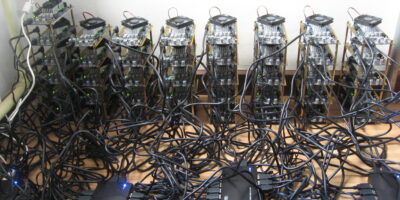Are All Cryptocurrencies Pyramid Schemes?

A Ponzi scheme sounds like something bad. Associated with frauds, swindling, and financially sophisticated theft, a Ponzi scheme is not something you want to be caught running. From the namesake himself, Charles Ponzi in the early 1900s, to the Bernie Madoff scam in the 1990s and 2000s, Ponzi schemes tend to be iconic, impressive, and go out with a bang. Their originators take in investor money under grand promises of extraordinary returns, pretend to invest them under some secret and home-grown formula, and pay out early-investor returns with the proceeds of new investors.
Like a cartoon snowball accelerating down the hillside, Ponzi schemes function for as long as the incoming money from new investors exceeds the returns (and withdrawals) to the old investors; once new funds slow down, the scheme unravels.
A slightly different structure of bogus financial wizardry is a pyramid scheme. In a pyramid scheme, the originator recruits people for some alleged task and those people in turn recruit even more people in a long chain of more and more participants; adding ever-larger layers to the bottom of the pyramid sustains its operation. Recruitment and sponsoring move down, financial transactions and bonuses move up. This way, early participants can profit handsomely and the wealth and prosperity of the people at the top of the pyramid are usually portrayed as inducements for new recruits. Those people started out exactly where you are, and they, like you, came from nothing (see Planet Money’s story of the Crypto Queen for a recent example).
Many people have called cryptocurrencies frauds and Ponzi schemes, which some of them most certainly are, but the most well-established probably aren’t. Indeed, they don’t quite qualify as Ponzi schemes since they rarely have a single originator running the show – but they are pyramid schemes. And this is a trivial statement.
So too are all successful forms of jewelry, wealth, property, and other moneys.
What Does “Money Holdings” Mean?
Once we take a step back and think about money in the context of pyramid schemes, its pyramid-like nature quickly becomes clear. Regardless of what material or digital imprint serves as money, in order to get money from somebody else, I first need to give up some valuable goods or services; I need to sell my stuff or provide some valuable work in exchange for which I am paid money.
When I first join a monetary network, I acquire some of its tokens by trading away something valuable of mine with somebody who already held the token – somebody higher up the pyramid. At any given time, somebody holds the tokens previously acquired after having given up valuable goods and services for them; there are more valuable goods and services produced than consumed, with the difference sitting in people’s money balances.
When I hold money, I do so on the reasonable presumption that I later will be able to offload this money for goods and services that I desire. In other words: I can even hold something of no particular use, say pieces of paper (actually, U.S. dollars are made of cotton and linen), and still be confident that its valuable properties can be forwarded to the next guy.
Cryptocurrencies and Pyramid Schemes
In a CNBC interview this week, Warren Buffett amusingly said that cryptocurrencies have no value since they don’t produce anything – ignoring, it seems, all the other financial and non-financial assets (commodities, derivatives, insurance) that, despite not “producing” anything, still have value. Instead, the reason people hold crypto in Buffett’s view, is a version of the Greater Fool Theory:
“What you hope is that somebody else comes along and pays you more money for it later on – but then that person’s got the problem.”
A lot of things have this property – among which: property itself! My parents’ generation paid much less for their housing than those of us coming after them will, with them pocketing the financial benefit of riding the house-price wave of the last decades. For early arrivers, wrote Kevin Erdmann in the recent issue of National Review, “the American dream seems to be a one-time asset bubble:”
“The owners of modest homes in, say, the Bay Area that now rent for $4,000 a month or that sell for a million dollars didn’t earn that wealth by creating something. Their profits are a direct result of policymakers’ preventing developers from building new housing units.”
Money balances work in a similar way: I give up valuable goods and services in exchange for something that provides me with benefits (for property, that benefit is the rental services of a home; for money, it’s the insurance against not being able to make an unexpected payment or future purchase) but does not generate interest or returns.
Economically, money balances represent purchasing power that I refrained from using. By holding cash balances, I push benefits up the monetary network’s pyramid; the value of the network’s tokens – their purchasing power relative to other goods and services – is higher than before, which benefits everybody who holds the tokens. It’s just like how owning a house yields you financial windfalls during a property-price boom, or adding a new layer of the pyramid scheme benefits early adopters.
A lot of people in the vaguely libertarian community have long held that gold simply is money. The same pyramid-style characteristic applies here: when more people hold gold, its purchasing power – what goods and services previous holders can obtain with a unit of gold – increases. Benefits are pushed up the financial pyramid.
Cryptocurrencies, Mr. Buffett is correct to point out, don’t “produce” anything or throw off a financial return. They, like gold or property or jewelry or rare Rembrandts, are bets along Greater Fool Theory lines that somebody else will come along later and pay an even higher price for them. This is no different than the mountain of cash that Mr. Buffett’s company holds – $128 billion according to the Economist: it produces nothing (except some below-inflation interest rate that Berkshire Hathaway might receive) but offers Mr. Buffett the ability to buy future businesses on the cheap, at lower prices than he currently observes.
Regardless of the exact format in which Mr. Buffett holds this cash, he benefits the entity that issued it: the short-term government bonds he holds reduce funding costs for the government or the funding costs of the bank or large corporate entity in which he holds deposits; holding physical cash allows the Federal Reserve to finance its portfolio of assets for free, generating seigniorage, with the Fed’s profit ultimately remitted to the Treasury.
In effect, Buffett’s holding cash in anticipation of great prices ahead provides free funding for the Fed, and by extension the government. Benefits go up the monetary pyramid.
A term coined by a 1960s French minister of finance, “Exorbitant Privilege,” describes the phenomenon that the holder of money bestows on its issuer. U.C. Berkeley Professor Barry Eichengreen even gave his 2012 book on the dollar that title as it refers to the “unfair” financial benefit accruing to an issuer of reserve currency. The U.S. could run larger current-account deficits and pay less for its debt since foreigners were willing to hold large amounts of its currency in its bank vaults.
We could say the same thing about today’s Swiss National Bank (SNB). Because a lot of people wish to hold Swiss francs as a financial safe haven, the SNB can satisfy their demand by producing more francs at no cost to themselves. They buy dollars and euros with their freshly issued francs, and – for monetary policy reasons – place a part of those foreign reserves in shares of foreign firms. According to the latest SEC numbers, the SNB’s portfolio of American stocks amounts to $100 billion, of which $10 billion alone consists of Apple, Microsoft, and Amazon stock.
The stream of income they earn on this portfolio is given to the SNB, free of charge, by foreigners simply willing to hold the Swiss franc. Think of it this way: foreigners who previously held dollars had the ability to purchase stock in Apple or Microsoft themselves, but preferred giving up that ability in exchange for a claim on the SNB.
When people give up real goods and services to an issuer of money, that issuer receives free stuff. Issue too much and the trust that underlies the relationship evaporates, destroying the issuer’s ability to receive free stuff; issue too little, and you don’t earn anything. Whether we’re discussing dollars issued by the Fed, francs by the SNB, gold by mining companies, or crypto tokens by a blockchain protocol, the same monetary attribute applies: the value of the token I receive depends on my ability to offload it to the next person – and every step of the way somebody gives away freebies in exchange for monetary tokens.
And while I hold the money, the tokens, or the gold, the issuer and other holders receive a financial benefit: the free funding (“seigniorage”) reaped by banks and central banks when you hold their liabilities, or Starbucks or Amazon when you hold their gift cards. For new holders of cryptocurrency, the monetary value flows to the seller one step up the pyramid and the OGs whose vast holdings increased in value.
All moneys and valuable items are pyramid schemes, and all holders of money and valuable items hope that the next person in line will pay more for them. That’s how monetary balances work. No big deal.











